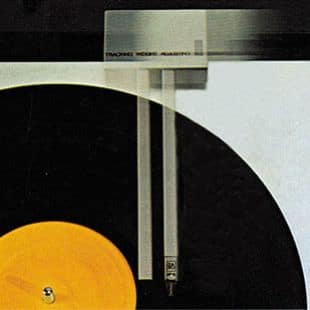(1) The anti-skating device is an integrated part of the arm
(2) With tangential arms, anti-skating devices are unnecessary
(3) The speed of the motor is kept constant , regardless of variations in mains current
Even for the experienced hi-fi enthusiast, choosing a record-player could be a headache which often ended in disappointment and irritation. This was because most high-fidelity record-players were sold as separate construction units. It was possible to buy a motor and a cabinet from one manufacturer, pick-up arm from another and finally, the cartridge from yet another. There was absolutely no guarantee that the very fine specifications of the individual components were maintained when they were finally connected into a record player.
For many years Bang & Olufsen’s philosophy was this: the greater the degree of integration a manufacturer could give his products by regarding each as an entity, the better the results for the customer. The demand for high specifications was increased in the mid-1970s by the advent of quadraphonic records. A quadraphonic system has to extract four separate sets of sound information from one record groove. An example of the precision equipment designed to meet these demands was Beogram 6000 – an integrated record-player with an electronically controlled tangential arm.

An LP is a work of art in two senses: the creative execution and the technique which inscribes musical experiences on to a disc which is both manageable and easy to store. The record is the programme source which has had greatest success in developing satisfactory standards to meet increasingly high demands: high-fidelity, stereo and later four-channel sound reproduction. Naturally, the products used for playing these records should be able to extract these qualities without losing or adding anything.
Surprisingly, the greatest demands are placed on the smallest unit in the complete system – the pick-up cartridge. The smaller and more compliant the stylus unit, the better and more precisely it traces the groove modulations, transforming them into electrical signals. The pressure which the diamond stylus exerts on the record is not more than 1-2 grams. It is therefore obvious that if the pick-up is to give of its best, the rest of the record-player should be of an equally exacting standard.
The record should rotate at a correct and constant speed. Meeting these demands is not just a question of how strong the motor is or how much the turntable weighs. It is of great importance that the various components are matched to give the optimum solution. Wow and flutter is the name given to unwanted variations in the tone level or frequency of the reproduced sound. It is easily heard on difficult piano pieces as an irritating “fluttering” vibration of an otherwise pure tone. It is measured in percentages. The lower the figure, the better.
Rumble is as the word says: a low, irritating rumbling noise – like faraway thunder. It comes either from the record or the mechanical transmission of the record-player. It is measured in dB, the higher the figure, the better. If you wonder why the turntable and the pick-up arm on a Bang & Olufsen record-player were elastically suspended, the answer is that this was a good way of reducing rumble.
If you placed a grooveless record on your turntable, the stylus would be automatically pulled towards the centre of the record. This phenomenon is called skating. It is unwanted because the “pull” results in greater exertion of stylus pressure on the inner groove wall. This skating effect must be reduced if high-fidelity standards are to be achieved. On Bang & Olufsen’s record-players the anti-skating device was automatic. It was not visible because it was an internally integrated part of the arm rather than an externally fitted device.
When cutting a record, the cutter-head moves in a straight line towards the centre of the record. It is only natural to use the same principle in play-back. However, manufacturers have declined because of the difficulties inherent in mechanical methods and, of course the price involved. Until the time that Beogram 4000 was introduced in 1974, all had been satisfied to let the arm trace an arc across the record’s radius. Bang & Olufsen’s tangential arm solved this problem. A servomotor moved the entire pick-up arm across the record in a straight line towards the centre. Skating was eliminated as there was no “pull” towards the centre of the record. An anti-skating device was unnecessary.
Bang & Olufsen’s record-players with tangential arms were electronically controlled: both for preparatory functions and functions during actual play. For example, the record player registered the size and speed of the record, electronically. The speed of the motor was kept constant, regardless of variations in mains current. It became really easy to play a record!
Collecting records is rather like collecting books. How much pleasure you can get and for how long (i.e. how many times you can play a record) depends on how you handle it. Friction, created when you remove a record from its sleeve, can give rise to static electricity causing the record to attract dust. Hold the sleeve so that the sides bend outwards from the record. Place your index finger in the centre and your thumb on the edge of the record. Do not touch the grooves. Remove the record carefully. Only the edges should touch the sleeve. Replace by reversing the procedure.